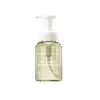What's inside
What's inside
 Key Ingredients
Key Ingredients

No key ingredients
 Benefits
Benefits

 Concerns
Concerns

 Ingredients Side-by-side
Ingredients Side-by-side

Artemisia Princeps Leaf Extract
Skin ConditioningWater
Skin ConditioningGlycerin
HumectantCoco-Betaine
CleansingDisodium Cocoamphodiacetate
CleansingButylene Glycol
HumectantMethylpropanediol
SolventLauryl Hydroxysultaine
CleansingChlorella Vulgaris Extract
Skin ConditioningOlea Europaea Fruit Oil
MaskingArtemisia Vulgaris Oil
PerfumingQuillaja Saponaria Bark Extract
CleansingRosmarinus Officinalis Leaf Oil
MaskingJuniperus Communis Fruit Oil
MaskingFerula Galbaniflua Resin Oil
AntimicrobialChrysanthemum Zawadskii Extract
Skin ConditioningPaeonia Lactiflora Root Extract
Skin Conditioning1,2-Hexanediol
Skin ConditioningSodium Chloride
MaskingSodium Citrate
BufferingC12-14 Alketh-12
EmulsifyingCoco-Glucoside
CleansingCitric Acid
BufferingCaprylyl Glycol
EmollientGlucose
HumectantPentylene Glycol
Skin ConditioningFructooligosaccharides
HumectantFructose
HumectantSodium Cocoyl Isethionate
CleansingSodium Phytate
Ethylhexylglycerin
Skin ConditioningArtemisia Princeps Leaf Extract, Water, Glycerin, Coco-Betaine, Disodium Cocoamphodiacetate, Butylene Glycol, Methylpropanediol, Lauryl Hydroxysultaine, Chlorella Vulgaris Extract, Olea Europaea Fruit Oil, Artemisia Vulgaris Oil, Quillaja Saponaria Bark Extract, Rosmarinus Officinalis Leaf Oil, Juniperus Communis Fruit Oil, Ferula Galbaniflua Resin Oil, Chrysanthemum Zawadskii Extract, Paeonia Lactiflora Root Extract, 1,2-Hexanediol, Sodium Chloride, Sodium Citrate, C12-14 Alketh-12, Coco-Glucoside, Citric Acid, Caprylyl Glycol, Glucose, Pentylene Glycol, Fructooligosaccharides, Fructose, Sodium Cocoyl Isethionate, Sodium Phytate, Ethylhexylglycerin
Water
Skin ConditioningGlycerin
HumectantSodium Sweetalmondamphoacetate
CleansingCoco-Betaine
CleansingGlutamic Acid
HumectantBifida Ferment Lysate
Skin ConditioningAllantoin
Skin ConditioningLactobacillus Ferment
Skin ConditioningLactobacillus Ferment Lysate
Skin ConditioningXylitylglucoside
HumectantAnhydroxylitol
HumectantXylitol
HumectantGlucose
HumectantButyrospermum Parkii Butter
Skin ConditioningVitis Vinifera Seed Oil
EmollientPanthenol
Skin ConditioningCaprylyl Glycol
EmollientSodium Phytate
Hydroxyacetophenone
Antioxidant1,2-Hexanediol
Skin ConditioningWater, Glycerin, Sodium Sweetalmondamphoacetate, Coco-Betaine, Glutamic Acid, Bifida Ferment Lysate, Allantoin, Lactobacillus Ferment, Lactobacillus Ferment Lysate, Xylitylglucoside, Anhydroxylitol, Xylitol, Glucose, Butyrospermum Parkii Butter, Vitis Vinifera Seed Oil, Panthenol, Caprylyl Glycol, Sodium Phytate, Hydroxyacetophenone, 1,2-Hexanediol
Ingredients Explained
These ingredients are found in both products.
Ingredients higher up in an ingredient list are typically present in a larger amount.
1,2-Hexanediol is a synthetic liquid and another multi-functional powerhouse.
It is a:
- Humectant, drawing moisture into the skin
- Emollient, helping to soften skin
- Solvent, dispersing and stabilizing formulas
- Preservative booster, enhancing the antimicrobial activity of other preservatives
Caprylyl Glycol is a humectant and emollient, meaning it attracts and preserves moisture.
It is a common ingredient in many products, especially those designed to hydrate skin. The primary benefits are retaining moisture, skin softening, and promoting a healthy skin barrier.
Though Caprylyl Glycol is an alcohol derived from fatty acids, it is not the kind that can dry out skin.
This ingredient is also used as a preservative to extend the life of products. It has slight antimicrobial properties.
Learn more about Caprylyl GlycolCoco-Betaine is the natural version of Cocamidopropyl Betaine. It is often derived from coconuts.
Coco-Betaine is a surfactant, meaning it helps remove dirt and oil from the skin.
Glucose is a simple sugar and is the most important source of energy in all organisms.
In skincare, glucose is used to hydrate the skin. It also acts as a prebiotic for our natural biome.
Glucose is hydrating due to its humectant property. As a humectant, glucose draws moisture from the air and from deeper levels in the skin.
Our skin contains many sugars that act as prebiotics and help strengthen our natural microbiome. Having a healthy microbiome helps protect our skin from harmful bacteria and other contaminants.
Studies show glucose may help with fading discoloration and pigmentation. This is because our skin metabolizes glucose into lactic acid. Lactic acid is an AHA that helps exfoliate the top layer of skin.
Learn more about GlucoseGlycerin is already naturally found in your skin. It helps moisturize and protect your skin.
A study from 2016 found glycerin to be more effective as a humectant than AHAs and hyaluronic acid.
As a humectant, it helps the skin stay hydrated by pulling moisture to your skin. The low molecular weight of glycerin allows it to pull moisture into the deeper layers of your skin.
Hydrated skin improves your skin barrier; Your skin barrier helps protect against irritants and bacteria.
Glycerin has also been found to have antimicrobial and antiviral properties. Due to these properties, glycerin is often used in wound and burn treatments.
In cosmetics, glycerin is usually derived from plants such as soybean or palm. However, it can also be sourced from animals, such as tallow or animal fat.
This ingredient is organic, colorless, odorless, and non-toxic.
Glycerin is the name for this ingredient in American English. British English uses Glycerol/Glycerine.
Learn more about GlycerinSodium Phytate is the synthetic salt form of phytic acid. Phytic acid is an antioxidant and can be found in plant seeds.
Sodium Phytate is a chelating agent. Chelating agents help prevent metals from binding to water. This helps stabilize the ingredients and the product.
Water. It's the most common cosmetic ingredient of all. You'll usually see it at the top of ingredient lists, meaning that it makes up the largest part of the product.
So why is it so popular? Water most often acts as a solvent - this means that it helps dissolve other ingredients into the formulation.
You'll also recognize water as that liquid we all need to stay alive. If you see this, drink a glass of water. Stay hydrated!
Learn more about Water